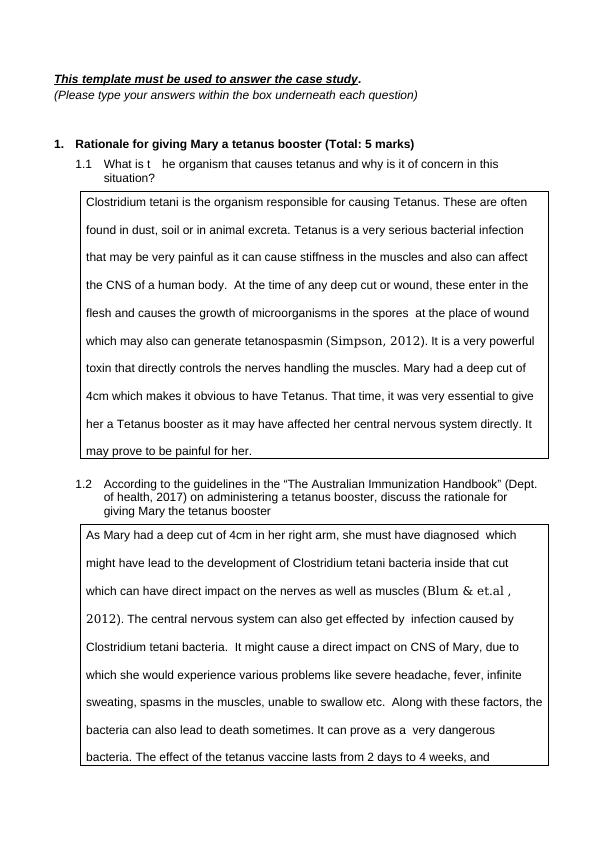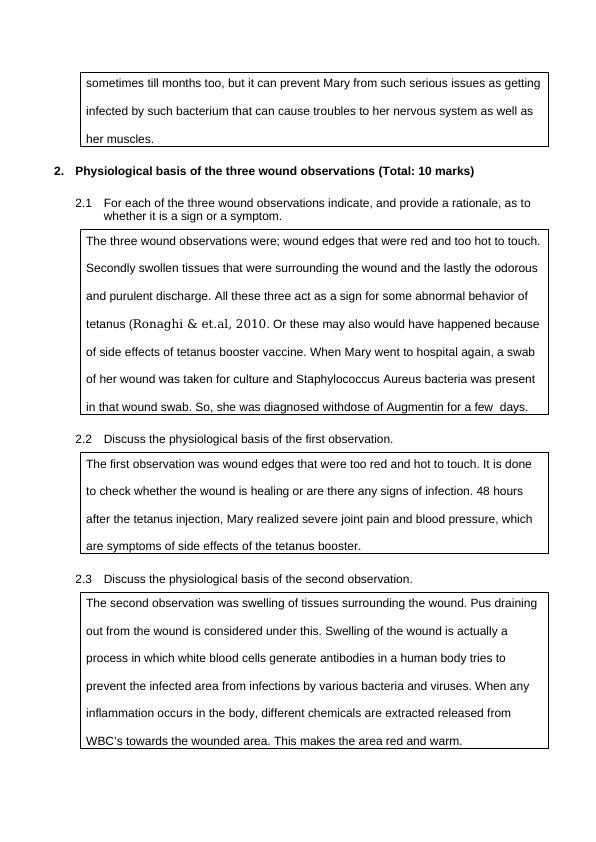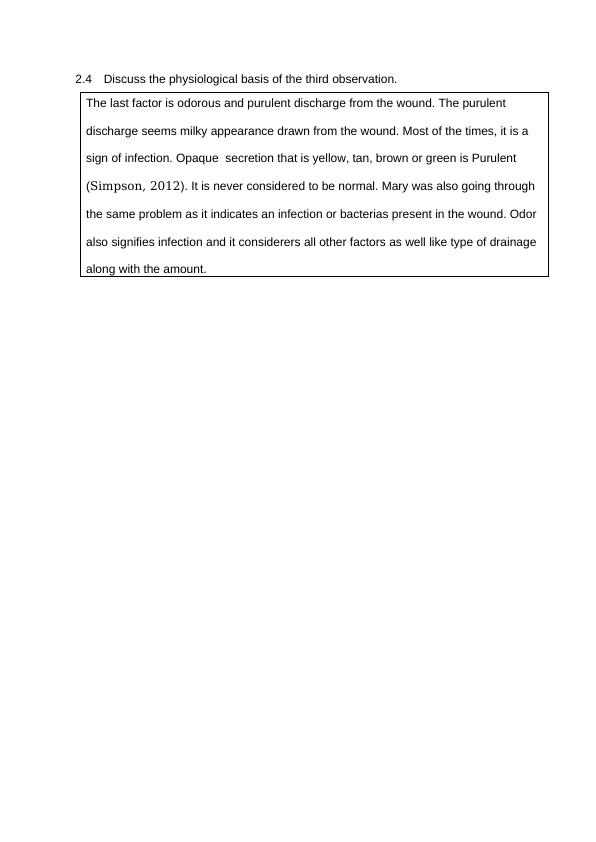Case Study on Tetanus Bacterial Infection
Added on 2020-06-05
6 Pages1991 Words96 Views
This template must be used to answer the case study. (Please type your answers within the box underneath each question)1.Rationale for giving Mary a tetanus booster (Total: 5 marks)1.1What is the organism that causes tetanus and why is it of concern in this situation? Clostridium tetani is the organism responsible for causing Tetanus. These are often found in dust, soil or in animal excreta. Tetanus is a very serious bacterial infection that may be very painful as it can cause stiffness in the muscles and also can affect the CNS of a human body. At the time of any deep cut or wound, these enter in the flesh and causes the growth of microorganisms in the spores at the place of wound which may also can generate tetanospasmin (Simpson, 2012). It is a very powerful toxin that directly controls the nerves handling the muscles. Mary had a deep cut of 4cm which makes it obvious to have Tetanus. That time, it was very essential to give her a Tetanus booster as it may have affected her central nervous system directly. It may prove to be painful for her. 1.2According to the guidelines in the “The Australian Immunization Handbook” (Dept. of health, 2017) on administering a tetanus booster, discuss the rationale for giving Mary the tetanus boosterAs Mary had a deep cut of 4cm in her right arm, she must have diagnosed which might have lead to the development of Clostridium tetani bacteria inside that cut which can have direct impact on the nerves as well as muscles (Blum & et.al , 2012). The central nervous system can also get effected by infection caused by Clostridium tetani bacteria. It might cause a direct impact on CNS of Mary, due to which she would experience various problems like severe headache, fever, infinite sweating, spasms in the muscles, unable to swallow etc. Along with these factors, thebacteria can also lead to death sometimes. It can prove as a very dangerous bacteria. The effect of the tetanus vaccine lasts from 2 days to 4 weeks, and

sometimes till months too, but it can prevent Mary from such serious issues as gettinginfected by such bacterium that can cause troubles to her nervous system as well as her muscles.2.Physiological basis of the three wound observations (Total: 10 marks) 2.1For each of the three wound observations indicate, and provide a rationale, as to whether it is a sign or a symptom.The three wound observations were; wound edges that were red and too hot to touch.Secondly swollen tissues that were surrounding the wound and the lastly the odorous and purulent discharge. All these three act as a sign for some abnormal behavior of tetanus (Ronaghi & et.al, 2010. Or these may also would have happened becauseof side effects of tetanus booster vaccine. When Mary went to hospital again, a swab of her wound was taken for culture and Staphylococcus Aureus bacteria was present in that wound swab. So, she was diagnosed withdose of Augmentin for a few days.2.2Discuss the physiological basis of the first observation.The first observation was wound edges that were too red and hot to touch. It is done to check whether the wound is healing or are there any signs of infection. 48 hours after the tetanus injection, Mary realized severe joint pain and blood pressure, which are symptoms of side effects of the tetanus booster. 2.3Discuss the physiological basis of the second observation.The second observation was swelling of tissues surrounding the wound. Pus draining out from the wound is considered under this. Swelling of the wound is actually a process in which white blood cells generate antibodies in a human body tries to prevent the infected area from infections by various bacteria and viruses. When any inflammation occurs in the body, different chemicals are extracted released from WBC’s towards the wounded area. This makes the area red and warm.

2.4Discuss the physiological basis of the third observation.The last factor is odorous and purulent discharge from the wound. The purulent discharge seems milky appearance drawn from the wound. Most of the times, it is a sign of infection. Opaque secretion that is yellow, tan, brown or green is Purulent (Simpson, 2012). It is never considered to be normal. Mary was also going through the same problem as it indicates an infection or bacterias present in the wound. Odor also signifies infection and it considerers all other factors as well like type of drainage along with the amount.

End of preview
Want to access all the pages? Upload your documents or become a member.
Related Documents
Organism and Tetanus Assignmentlg...
|5
|2139
|1131
The Australian Immunisation Handbook | Studylg...
|7
|2030
|118
(PDF) Clostridium tetani as a pathogenic organismlg...
|5
|1814
|193
Tetanus | Answer to Questionslg...
|6
|1573
|411
NURSING BIOSCIENCE Assignmentlg...
|7
|1557
|174
Nursing Related Questions and Answerslg...
|8
|1683
|416
